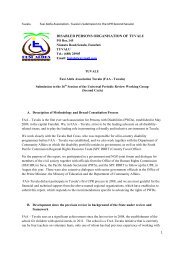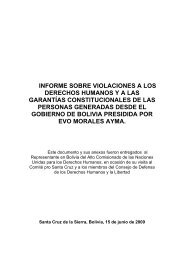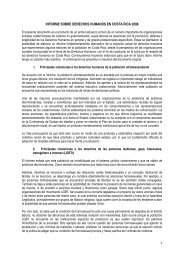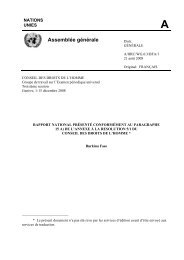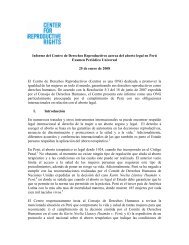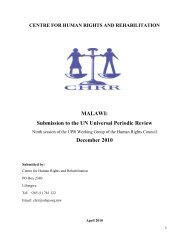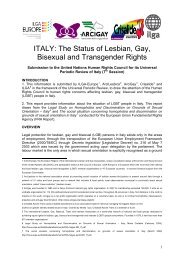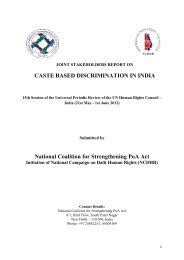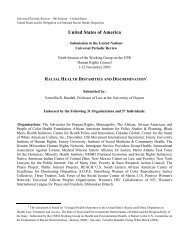Prison Needle Exchange: Lessons from a Comprehensive Review ...
Prison Needle Exchange: Lessons from a Comprehensive Review ...
Prison Needle Exchange: Lessons from a Comprehensive Review ...
You also want an ePaper? Increase the reach of your titles
YUMPU automatically turns print PDFs into web optimized ePapers that Google loves.
• do not endanger staff or prisoner safety, and in fact, make prisons safer places to live<br />
and work;<br />
• do not increase drug consumption or injecting;<br />
• reduce risk behaviour and disease (including HIV and HCV) transmission;<br />
• have other positive outcomes for the health of prisoners;<br />
• have been effective in a wide range of prisons; and<br />
• have successfully employed different methods of needle distribution to meet the needs<br />
of staff and prisoners in a range of prisons.<br />
Recommendation<br />
This report makes one recommendation, directed at government and prison officials in<br />
Canada: Both federal and provincial/territorial correctional services in Canada should immediately<br />
take steps to implement multi-site pilot needle exchange programs. Although the last<br />
chapter (“<strong>Needle</strong> <strong>Exchange</strong> Programs Should Be Implemented in <strong>Prison</strong>s in Canada”) focuses<br />
on Canada, this recommendation also applies to other countries in which prison systems<br />
face HIV and HCV epidemics driven by injection drug use.<br />
What does this report contain?<br />
The first chapter (<strong>Prison</strong>er Health Is a Public Health Issue) provides an introduction to the<br />
issue of prisoner health and needle exchange in prisons in the context of injection drug use,<br />
HIV, and HCV in prison. The second chapter (Methodology) reviews the methods used to<br />
gather evidence for the report. The third chapter (HIV and HCV Epidemics in <strong>Prison</strong>) summarizes<br />
evidence of HIV and HCV prevalence, injection drug use, and needle sharing in<br />
prisons worldwide. The Canadian evidence is reviewed in greater detail. The fourth chapter<br />
(Human Rights and Legal Standards) sets out the human rights, legal standards, and guidelines<br />
relevant to injection drug use, HIV, and HCV in prisons. The legal obligation of governments<br />
to respect, protect, and fulfill prisoners’ right to health, including the right to preventive<br />
health measures, is examined. The specific legal context in Canada is also examined.<br />
The fifth chapter (<strong>Review</strong> of International Evidence of <strong>Prison</strong> <strong>Needle</strong> <strong>Exchange</strong>) reviews the<br />
experience and evidence <strong>from</strong> the six above-mentioned countries with prison needle<br />
exchange programs that were studied for this report – Switzerland, Germany, Spain,<br />
Moldova, Kyrgyzstan, and Belarus. For each country the review includes, where available,<br />
epidemiological information about HIV and HCV, both in the general population and in<br />
prison; a history of the prison system’s response to HIV and HCV; a review of prison needle<br />
exchange programs, including historical information, evaluations, and lessons learned;<br />
the current situation; and future directions.<br />
The sixth chapter (Analysis of the Evidence) draws on the evidence <strong>from</strong> the literature<br />
review and prison visits to present the findings concerning prison needle exchange programs.<br />
The seventh chapter (<strong>Needle</strong> <strong>Exchange</strong> Programs Should Be Implemented in <strong>Prison</strong>s in<br />
Canada) draws on the findings <strong>from</strong> the previous chapter to present the case for the implementation<br />
of needle exchange programs in federal and provincial/territorial prisons in<br />
Canada. The eighth and final chapter (Conclusion: A call for leadership on prison needle<br />
exchange programs) calls for leadership on the issue <strong>from</strong> elected officials, prison authorities,<br />
individual prison staff (both correctional staff and health service staff), and outside<br />
physicians who work in prisons.<br />
Executive Summary xi



